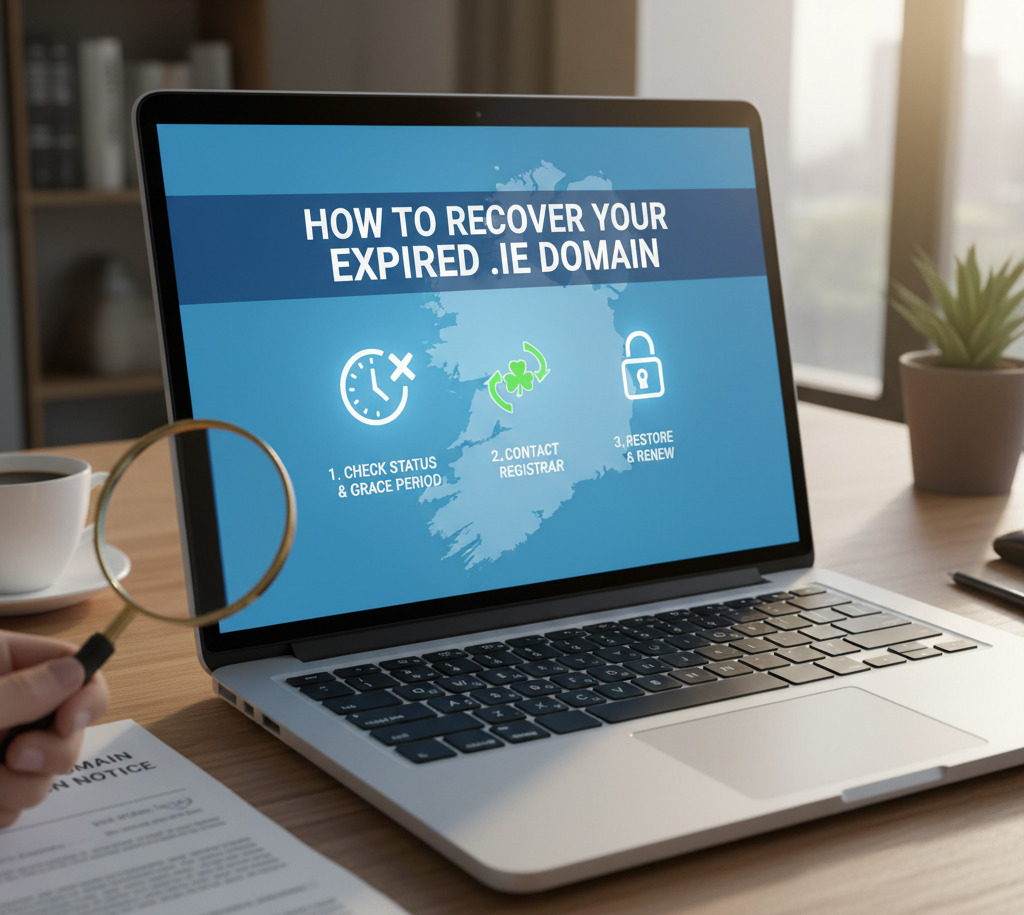Your .ie domain expired last night. This morning, your website displays an error message. Your business emails bounce back to customers. Your online presence has vanished overnight. This scenario plays out for thousands of Irish businesses each year. Many owners assume they’ll get plenty of warning before their domain stops working. The reality is harsher. Domain expiry affects your website, email, and business reputation instantly. But the story doesn’t end there. Understanding what happens next could save your business from permanent loss.
Your Website and Email Stop Working Immediately
The moment your .ie domain hits its expiry date, everything connected to it shuts down. No grace period. No “almost expired” warning page.
Your website becomes unreachable. Customers typing in your web address get error messages instead of your homepage. Email addresses linked to your domain stop receiving messages. Suppliers trying to contact you get bounce-back notifications.
Your website becomes unreachable. Customers typing in your web address get error messages instead of your homepage. Email addresses linked to your domain stop receiving messages. Suppliers trying to contact you get bounce-back notifications.
This immediate cutoff catches many business owners off guard. They expect domains to work like magazine subscriptions – continuing for a few weeks while renewal notices pile up. .ie domains don’t work this way. The Irish domain system prioritises accuracy over convenience. When your registration period ends, your services end too.
The Grace Period: You Have Up to 45 Days
After your domain expires, it enters a grace period lasting up to 45 days. During this time, your registrar holds the domain name for you.
Think of this as a safety net. Your domain won’t be released to the public yet. No one else can register it while you’re in the grace period.
However, your website and email remain offline throughout this period. The grace period protects your right to renew, but it doesn’t restore your services. Renewal during the grace period costs the same as a standard renewal. No extra fees or penalties apply. Your registrar simply processes your payment and reactivates your domain. Most registrars send multiple renewal notices before and during this period. Check your spam folder – these emails often end up there.
Think of this as a safety net. Your domain won’t be released to the public yet. No one else can register it while you’re in the grace period.
However, your website and email remain offline throughout this period. The grace period protects your right to renew, but it doesn’t restore your services. Renewal during the grace period costs the same as a standard renewal. No extra fees or penalties apply. Your registrar simply processes your payment and reactivates your domain. Most registrars send multiple renewal notices before and during this period. Check your spam folder – these emails often end up there.
Redemption Period: Last Chance But Higher Costs
Miss the grace period? Your domain moves into redemption status around day 41 after expiry. The Domain Registry of Ireland has recently introduced a redemption period, where the domain can be renewed but for an additional fee. The redemption period lasts approximately 30 days (until around day 70 total). You can still recover your domain, but the process becomes more expensive and complicated. Many registrars charge redemption fees on top of standard renewal costs. These fees cost €60 plus VAT in addition to the domain renewal fee.
Your domain remains protected during redemption. Other people still can’t register it. But the clock is ticking faster now. Some registrars require manual intervention to restore domains from redemption. This means longer waiting times compared to standard renewals.
Deletion and Release
After roughly 70 days total, your domain gets deleted from the registry. It becomes available for anyone to register on a first-come, first-served basis. This is where businesses face permanent loss. Once someone else registers your expired domain,
recovering it becomes extremely difficult and expensive. Domain speculators monitor expiring domains, especially those with established websites or good search rankings. They may register your old domain immediately after deletion. Getting your domain back from a new owner typically requires negotiation and substantial payment. Some domain investors demand thousands of euros for valuable domains.
recovering it becomes extremely difficult and expensive. Domain speculators monitor expiring domains, especially those with established websites or good search rankings. They may register your old domain immediately after deletion. Getting your domain back from a new owner typically requires negotiation and substantial payment. Some domain investors demand thousands of euros for valuable domains.
How to Recover Your Expired .ie Domain


Acting quickly gives you the best chance of domain recovery.
Here’s what to do:
Check your domain status using the IEDR WHOIS lookup tool. This tells you exactly where your domain sits in the expiry process.
Contact your registrar immediately. Most registrars have dedicated renewal departments that can process urgent requests quickly.
Gather payment information. Have your credit card or bank details ready. Delays in payment processing could push your domain into the next expiry stage.
Update your contact details if they’ve changed. Registrars often refuse to process renewals if they can’t verify account ownership.
If your domain has already been deleted and re-registered, you have limited options. Contact the new owner through the WHOIS database. Be prepared for high purchase prices or outright refusal to sell.
Prevention Strategies That Actually Work
Enable auto-renewal through your registrar’s control panel. This prevents accidental expiry even if you forget renewal dates.
Keep billing information current. Auto-renewal fails if your credit card expires or bank details change. Update payment methods before they expire.
Keep billing information current. Auto-renewal fails if your credit card expires or bank details change. Update payment methods before they expire.
Set personal reminders for 30 days before expiry. Don’t rely solely on registrar emails – they may not reach you.
Monitor multiple domains together if you own several. Create a spreadsheet with all expiry dates. Review it monthly.
Consider longer registration periods. Registering for 2-5 years reduces the frequency of renewal requirements. .ie domain expiry hits hard and fast. Your business goes dark immediately when your registration ends.
Consider longer registration periods. Registering for 2-5 years reduces the frequency of renewal requirements. .ie domain expiry hits hard and fast. Your business goes dark immediately when your registration ends.
You get up to 40 days of grace period renewal at normal prices. Miss that window, and redemption fees kick in. Wait too long, and your domain disappears forever. The good news? Recovery is usually possible if you act within 70 days. After that, you’re at the mercy of whoever registers your old domain name.
Don’t gamble with your online presence. Set up auto-renewal today. Your future self will thank you when your domain renews automatically instead of vanishing overnight.

